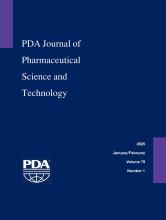Abstract
Analytical similarity is the foundation for demonstration of biosimilarity between a proposed product and a reference product. For this assessment, currently the FDA recommends a tiered system in which quality attributes are categorized into three tiers commensurate with their risk and approaches of varying statistical rigor are subsequently used for the three-tier quality attributes. Key to the analyses of Tiers 1 and 2 quality attributes is the establishment of equivalence acceptance criterion and quality range. For particular licensure applications, the FDA has provided advice on statistical methods for demonstration of analytical similarity. For example, for Tier 1 assessment, an equivalence test can be used based on an equivalence margin of 1.5 , where is the reference product variability estimated by the sample standard deviation from a sample of reference lots. The quality range for demonstrating Tier 2 analytical similarity is of the form where the constant K is appropriately justified. To demonstrate Tier 2 analytical similarity, a large percentage (e.g., 90%) of test product must fall in the quality range. In this paper, through both theoretical derivations and simulations, we show that when the reference drug product (DP) lots are correlated, the sample standard deviation underestimates the true reference product variability . As a result, substituting for in the Tier 1 equivalence acceptance criterion and the Tier 2 quality range inappropriately reduces the statistical power and the ability to declare analytical similarity. Also explored is the impact of correlation among DP lots on Type I error rate and power. Three methods based on generalized pivotal quantities are introduced, and their performance is compared against a two-one-sided tests (TOST) approach. Finally, strategies to mitigate risk of correlation among the reference products lots are discussed.
- Acceptance criteria
- Analytical similarity
- Biosimilar
- Equivalence testing
- Generalized pivotal quantity
- Stepwise approach
- Received February 4, 2016.
- Accepted June 13, 2016.
- Copyright © 2016, Parenteral Drug Association
PDA members receive access to all articles published in the current year and previous volume year. Institutional subscribers received access to all content. Log in below to receive access to this article if you are either of these.
If you are neither or you are a PDA member trying to access an article outside of your membership license, then you must purchase access to this article (below). If you do not have a username or password for JPST, you will be required to create an account prior to purchasing.
Full issue PDFs are for PDA members only.
Note to pda.org users
The PDA and PDA bookstore websites (www.pda.org and www.pda.org/bookstore) are separate websites from the PDA JPST website. When you first join PDA, your initial UserID and Password are sent to HighWirePress to create your PDA JPST account. Subsequent UserrID and Password changes required at the PDA websites will not pass on to PDA JPST and vice versa. If you forget your PDA JPST UserID and/or Password, you can request help to retrieve UserID and reset Password below.






